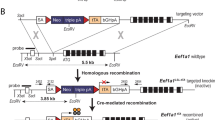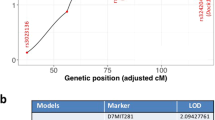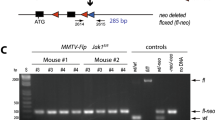Abstract
We describe the construction and phenotypic characterization of 23 whey acidic protein (WAP)-mutp53 transgenic mouse lines. The mutp53-expressing lines showed a mosaic expression pattern for the transgenes, leading to a heterogeneous yet mouse line-specific expression pattern for mutp53 upon induction. Only few lines were obtained, in which the majority of the induced mammary epithelial cells expressed the mutp53 transgene, most of the transgenic lines did not express mutp53, or expressed the transgene in less than 2% of the induced mammary epithelial cells. Hormone requirements for mutp53 transgene expression from the WAP-promoter differed in high and low expressing lines, being low in high expressing lines, and even lower in multiparous mutp53 mice, where persistent expression of the transgene occurred. Repeated induction of mutp53 expression through repeated parturition resulted in the formation of expanding mutp53-expressing foci within the mammary alveolar epithelium. The data suggest that epigenetic mechanisms play a role in modulating the expression of the mutp53 transgene. To support this idea, we crossed a nonexpressing WAP-mutp53 line with a strongly SV40 T-antigen-expressing WAP-T mouse line. In the bitransgenic mice, T-antigen-induced chromatin remodeling led to re-expression of epigenetically silenced mutp53 transgene(s). In these mice, mutp53 expression was much more variable compared to SV40 T-antigen expression, and seemed to depend on the coexpression of SV40 T-antigen. Mutp53 expression in this system thus resembles the situation in many human tumors, where one can observe a heterogeneous expression of mutp53, despite a homogeneous distribution of the p53 mutation in the tumor cells.
This is a preview of subscription content, access via your institution
Access options
Subscribe to this journal
Receive 50 print issues and online access
$259.00 per year
only $5.18 per issue
Buy this article
- Purchase on Springer Link
- Instant access to full article PDF
Prices may be subject to local taxes which are calculated during checkout








Similar content being viewed by others
References
Aas T, Borresen AL, Geisler S, Smith-Sorensen B, Johnsen H, Varhaug JE, Akslen LA and Lonning PE . (1996). Nat. Med., 2, 811–814.
Andres AC, Schonenberger CA, Groner B, Henninghausen L, LeMeur M and Gerlinger P . (1987). Proc. Natl. Acad. Sci. USA, 84, 1299–1303.
Bakkenist CJ and Kastan MB . (2003). Nature, 421, 499–506.
Bartoli A, Fettucciari K, Fetriconi I, Rosati E, Ianni MD, Tabilio A, Delfino DV, Rossi R and Marconi P . (2003). Pharmacol. Res., 48, 111–118.
Borresen-Dale AL . (2003). Hum. Mutat., 21, 292–300.
Brinster RL, Allen JM, Behringer RR, Gelinas RE and Palmiter RD . (1988). Proc. Natl. Acad. Sci. USA, 85, 836–840.
Burdon T, Sankaran LJ, Wall RJ, Spencer M and Hennighausen L . (1991). J. Biol. Chem., 266, 6909–6914.
Cameron EE, Bachman KE, Myohanen S, Herman JG and Baylin SB . (1999). Nat. Genet, 21, 103–107.
Chen W, Possemato R, Campbell KT, Plattner CA, Pallas DC and Hahn WC . (2004). Cancer Cell, 5, 127–136.
Deppert W, Goehler T, Koga H and Kim E . (2000). J. Cell. Biochem., 115–122.
Deppert W and Pates R . (1979). J. Virol., 31, 522–536.
Ebina M, Martinez A, Birrer MJ and Ilona Linnoila R . (2001). Oncogene, 20, 2579–2586.
Eliyahu D, Michalovitz D and Oren M . (1985). Nature, 316, 158–160.
Felix CA, Strauss EA, D'Amico D, Tsokos M, Winter S, Mitsudomi T, Nau MM, Brown DL, Leahey AM, Horowitz ME, Poplack DG, Costin D and Minna JD . (1993). Oncogene, 8, 1203–1210.
Field J, Nikawa J, Broek D, MacDonald B, Rodgers L, Wilson IA, Lerner RA and Wigler M . (1988). Mol. Cell. Biol., 8, 2159–2165.
Goh HS, Yao J and Smith DR . (1995). Cancer Res., 55, 5217–5221.
Gottlicher M, Minucci S, Zhu P, Kramer OH, Schimpf A, Giavara S, Sleeman JP, Lo Coco F, Nervi C, Pelicci PG and Heinzel T . (2001). EMBO J., 20, 6969–6978.
Hanash S . (2004). Nat. Rev. Cancer, 4, 638–644.
Heinrichs S and Deppert W . (2003). Oncogene, 22, 555–571.
Hogan B, Costantini F and Lacy E . (1986). Manipulating the Mouse Embryo. Cold Spring Harbor Laboratory Press: Cold Spring harbor, New York.
Horio Y, Suzuki H, Ueda R, Koshikawa T, Sugiura T, Ariyoshi Y, Shimokata K and Takahashi T . (1994). Oncogene, 9, 1231–1235.
Jhappan C, Geiser AG, Kordon EC, Bagheri D, Hennighausen L, Roberts AB, Smith GH and Merlino G . (1993). EMBO J., 12, 1835–1845.
Jiao J and Simmons DT . (2003). J. Virol., 77, 12720–12728.
Kim E and Deppert W . (2004). J. Cell. Biochem., 93, 878–886.
Klawitz I, Preuss U and Scheidtmann KH . (2001). Int. J. Oncol., 19, 1325–1332.
Kramer OH, Zhu P, Ostendorff HP, Golebiewski M, Tiefenbach J, Peters MA, Brill B, Groner B, Bach I, Heinzel T and Gottlicher M . (2003). EMBO J., 22, 3411–3420.
Krnacik MJ, Li S, Liao J and Rosen JM . (1995). J. Biol. Chem., 270, 11119–11129.
Kuperwasser C, Hurlbut GD, Kittrell FS, Dickinson ES, Laucirica R, Medina D, Naber SP and Jerry DJ . (2000). Am. J. Pathol., 157, 2151–2159.
Lazar H, Baltzer A, Gimmi C, Marti A and Jaggi R . (2000). Int. J. Cancer, 85, 578–583.
Li B, Greenberg N, Stephens LC, Meyn R, Medina D and Rosen JM . (1994). Cell Growth Differ., 5, 711–721.
Li BL, Murphy KL, Laucirica R, Kittrell F, Medina D and Rosen JM . (1998). Oncogene, 16, 997–1007.
Li D, Zhao R, Lilyestrom W, Gai D, Zhang R, DeCaprio JA, Fanning E, Jochimiak A, Szakonyi G and Chen XS . (2003). Nature, 423, 512–518.
Li S and Rosen JM . (1994). J. Biol. Chem., 269, 14235–14243.
Lozano G and Levine AJ . (1991). Mol. Carcinog., 4, 3–9.
McKnight RA, Shamay A, Sankaran L, Wall RJ and Hennighausen L . (1992). Proc. Natl. Acad. Sci. USA, 89, 6943–6947.
McKnight RA, Spencer M, Wall RJ and Hennighausen L . (1996). Mol. Reprod. Dev., 44, 179–184.
McKnight RA, Wall RJ and Hennighausen L . (1995). Transgenic Res., 4, 39–43.
Milavetz BI . (2002). Virology, 294, 170–179.
Murphy KL and Rosen JM . (2000). Oncogene, 19, 1045–1051.
Olivier M, Eeles R, Hollstein M, Khan MA, Harris CC and Hainaut P . (2002). Hum. Mutat., 19, 607–614.
Pittius CW, Hennighausen L, Lee E, Westphal H, Nicols E, Vitale J and Gordon K . (1988a). Proc. Natl. Acad. Sci. USA, 85, 5874–5878.
Pittius CW, Sankaran L, Topper YJ and Hennighausen L . (1988b). Mol. Endocrinol., 2, 1027–1032.
Rahko E, Blanco G, Soini Y, Bloigu R and Jukkola A . (2003). Eur. J. Cancer, 39, 447–453.
Robinson GW, McKnight RA, Smith GH and Hennighausen L . (1995). Development, 121, 2079–2090.
Sandgren EP, Schroeder JA, Qui TH, Palmiter RD, Brinster RL and Lee DC . (1995). Cancer Res., 55, 3915–3927.
Schirmbeck R and Deppert W . (1991). J. Virol., 65, 2578–2588.
Schmitt MK and Mann K . (1987). Virology, 156, 268–281.
Schoenenberger CA, Andres AC, Groner B, van der Valk M, LeMeur M and Gerlinger P . (1988). EMBO J., 7, 169–175.
Schulze-Garg C, Löhler J, Gocht A and Deppert W . (2000). Oncogene, 19, 1028–1037.
Seinsoth S, Uhlmann-Schiffler H and Stahl H . (2003). EMBO Rep., 4, 263–268.
Sherr CJ . (2000). Cancer Res., 60, 3689–3695.
Sigal A and Rotter V . (2000). Cancer Res., 60, 6788–6793.
Simmons DT, Gai D, Parsons R, Debes A and Roy R . (2004). Nucleic Acids Res., 32, 1103–1112.
Slack A, Cervoni N, Pinard M and Szyf M . (1999). J. Biol. Chem., 274, 10105–10112.
Smalley MJ, Titley J and O'Hare MJ . (1998). In vitro Cell Dev. Biol. Anim., 34, 711–721.
Staufenbiel M and Deppert W . (1983). Cell, 33, 173–181.
Tiemann F and Deppert W . (1994). Oncogene, 9, 1907–1915.
Tolstonog GV, Wang X, Shoeman R and Traub P . (2000). DNA Cell Biol., 19, 647–677.
Tzeng YJ, Guhl E, Graessmann M and Graessmann A . (1993). Oncogene, 8, 1965–1971.
Valls E, de la Cruz X and Martinez-Balbas MA . (2003). Nucleic Acids Res., 31, 3114–3122.
Voorhoeve PM and Agami R . (2003). Cancer Cell, 4, 311–319.
Wagner KU, Wall RJ, St-Onge L, Gruss P, Wynshaw-Boris A, Garrett L, Li M, Furth PA and Hennighausen L . (1997). Nucleic Acids Res., 25, 4323–4330.
Zgouras D, Becker U, Loitsch S and Stein J . (2004). Biochem. Biophys. Res. Commun., 316, 693–697.
Zhang YP, Xiong Y and Yarbrough WG . (1998). Cell, 92, 725–734.
Zhou Q, McCracken MA and Strobl JS . (2002). Breast Cancer Res. Treat, 75, 107–117.
Acknowledgements
We thank Dr M Bösl, Zentrum für Molekulare Neurobiologie der Universität Hamburg (ZMNH) for help with the microinjection experiments, Ms A Diesterbeck and Ms K Heigl for expert technical help, and Ms M Hintz-Malchow for editing the manuscript. This research was supported by grants from the Deutsche Forschungsgemeinschaft (SFB 545), from the Erich and Gertrud Roggenbuck-Stiftung, the EC (QLG1-1999-00273), and by EC FP6 funding. The Heinrich-Pette-Institut is financially supported by Freie und Hansestadt Hamburg and Ministerium für Gesundheit und Soziale Sicherung. This publication reflects the author's views and not necessarily those of the EC. The Community is not liable for any use that may be made of the information contained herein. The work described herein is part of the Ph.D. thesis by CH.
Author information
Authors and Affiliations
Corresponding author
Rights and permissions
About this article
Cite this article
Krepulat, F., Löhler, J., Heinlein, C. et al. Epigenetic mechanisms affect mutant p53 transgene expression in WAP-mutp53 transgenic mice. Oncogene 24, 4645–4659 (2005). https://doi.org/10.1038/sj.onc.1208557
Received:
Revised:
Accepted:
Published:
Issue Date:
DOI: https://doi.org/10.1038/sj.onc.1208557
Keywords
This article is cited by
-
Elastic transformation of histological slices allows precise co-registration with microCT data sets for a refined virtual histology approach
Scientific Reports (2021)
-
Understanding wild-type and mutant p53 activities in human cancer: new landmarks on the way to targeted therapies
Cancer Gene Therapy (2011)
-
Recent advances in p53 research: an interdisciplinary perspective
Cancer Gene Therapy (2009)



